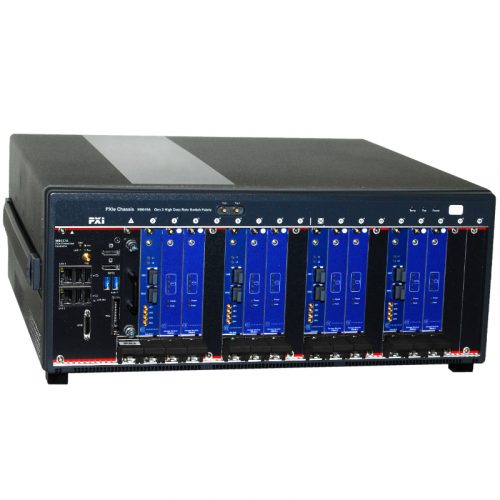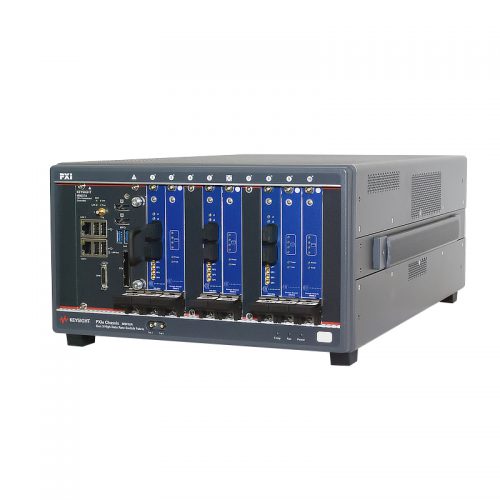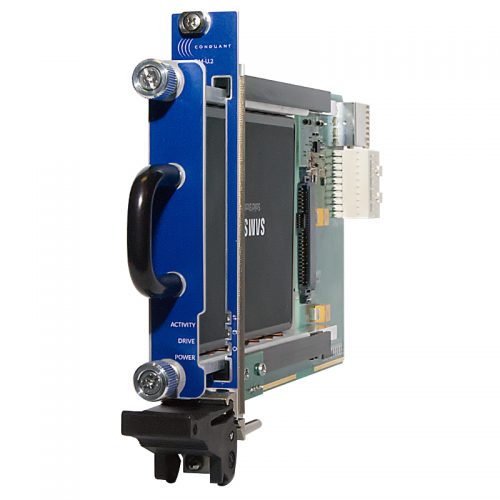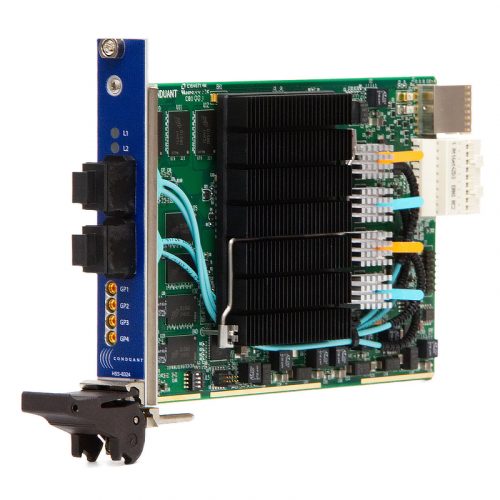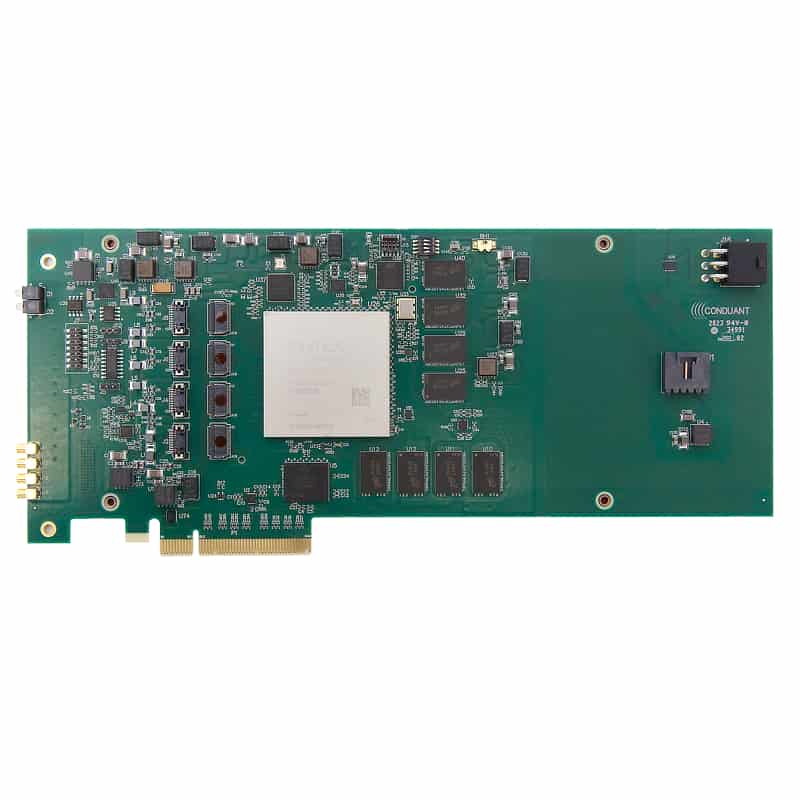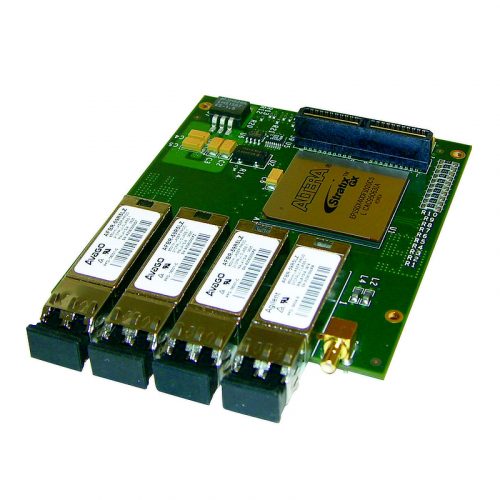-
Modular & Flexible
The Cobra High Speed Recorder is a unique solution for high speed data recording and playback at a rate of up to 20 GB/s (160 Gbps). The system utilizes the PXI Express architecture to provide a modular, flexible solution that can be customized to nearly any requirement. The main recording engine, Cobra, is a PXIe board with high speed RAM and a high performance Xilinx FPGA. This board manages the data movement to and from storage devices and also provides optical fiber channels for high speed data input or output. The Cobra board can be used alone or in concert with additional Cobra boards.
A typical system configuration will include an Intel processor based controller, one or more Cobra boards, and one or more SSD based storage boards. The PXI Express backplane allows numerous configurations and combinations of storage and recorder boards to match nearly any requirement. Extended systems can also employ an additional chassis to provide additional storage capacity if desired.
Peer-to-Peer PCI Express
Conduant’s StreamStor® architecture provides the capability to move data on the PCI Express fabric using Peer-to-Peer techniques. This allows direct hardware data streaming from A/D or other PCI Express sources to or from the data storage without being impaired by system bottlenecks. The system can also accept data from multiple PCI Express sources simultaneously.
Command/Control
The Cobra High Speed Recorder can operate independently from a host computer with command/control performed over a network connection. Control can also be automated from a software application using the StreamStor® software API on a network connected computer. A cabled PCI Express option provides connectivity to a host computer for command/control and/or high-speed data access. The cabled PCI Express option provides a 64 Gbps link that can be optionally extended to support long distance links using a PCI Express fiber optic cable.
Solid State Storage
The standard storage devices used in the Cobra High Speed Recorder system are M.2 NVMe PCI Express solid state drives. These devices are installed with up to 4 per PXI Express slot using the DM-4M.2 Storage Unit. These drives are available in capacities up to 4 TB each, with even higher capacities expected in the future. The use of solid state drives provides consistent performance even with high levels of shock and vibration. Current standard configurations support up to 128 TB of storage in a 4U 22″ deep chassis. Check with your Conduant sales representative for the latest available storage offerings compatible with the Cobra system.
High Speed Serial (Optical)
The Xilinx FPGA on the Cobra board optionally includes up to 24 channels (48 fibers) of high speed optical and can be configured to support many different high speed serial protocols. The protocols possible over these interfaces include ODI (Optical Data Interface), Interlaken, Serial FPDP, and Aurora. Other interfaces can be added according to customer requirements.
The optical interfaces can also be used to extend the recorder performance. For example, an ODI recorder is capable of 160 Gbps using 4 recorders and a 12 x 14.1 Gbps interface. The optical interface provides a high speed data path that is daisy chained to each recorder so that the speed capability is aggregated across the cooperating recorders.
The 24 optical fibers can be tailored to customer requirements by bonding channels to create higher speed channels or used independently to record large numbers of slower channels. The Xilinx FPGA also allows Conduant the flexibility to customize an implementation for a particular protocol.
Trigger/Sync Capability
The Cobra hardware is connected to the PXI Express backplane instrumentation signals and also has front panel signal connectors. These signal sources can be adapted to customer requirements to provide unique capabilities required for a customer application—triggers, event marking, etc.
Software API
The included software development kit (SDK) includes support for .NET development environments. This includes languages such as C#, Visual Basic, and C++ CLI. The SDK also includes a complete “C” based interface to facilitate usage of nearly any programming language. This includes programming environments such as LabVIEW and MATLAB.
The SDK includes support for features such as wrap mode (circular buffer) for very long duration recording, playback looping, and multiple recording (file) management. Additional features are added regularly and the software can be customized as needed.
-
The Big River™ DM-125-3U PXI Express Storage Unit provides disk storage resources to PCI Express based systems. By providing an internal enclosure for disk storage, the DM-125 allows high speed storage applications to be designed around a standard PXIe chassis.
The single slot design of the DM-125 increases the availability of valuable chassis slots when compared to other solutions and allows for maximum storage flexibility. The DM-125 offers capacities of up to 2 TB SSD storage in a single unit at a competitive price point. The DM-125 is an economical solution to PXIe disk storage obstacles while also supplying ample performance.
PXIe storage modules offered by Conduant are compatible with all major PXI Express chassis models, including National Instruments (NI) and Keysight Technologies.
Full list of compatible PXIe chassis models:
Compatible National Instruments Chassis ModelsPXIe1062Q
PXIe1065
PXIe1066DC
PXIe1073
PXIe1078
PXIe1082
PXIe1082DC
PXIe1085
PXIe1086
PXIe1086DC
PXIe1090
PXIe1092
PXIe1095
Compatible Keysight Chassis ModelsM9019A
M9018B
M9010A
M9005A
-
The Big River™ DM-4M.2-3U PXI Express storage unit provides up to 15.2 TB of NVME SSD storage in a single PXI Express slot. The DM-4M.2 has a PCI Express Gen3 x8 host interface (up to 8GB/s). With the latest NVME SSD storage, the board delivers high speed data rates for sequential writes of 7.1 GB/s and for sequential reads of 7.1 GB/s in Gen3 PXI Express based systems.
The single slot design of the DM-4M.2 increases the availability of valuable chassis slots when compared to other solutions and allows for maximum storage flexibility. The DM-4M.2 complies with PCIe Gen3 protocol standards and uses industry standard NVME SSD storage devices. The DM-4M.2 operates under Windows 7, 8.1, and 10, and can utilize the software RAID feature of Windows to combine up to 4 devices on the board into a single addressable device.
PXIe storage modules offered by Conduant are compatible with all major PXI Express chassis brands, including National Instruments (NI) and Keysight.
Full list of compatible PXIe chassis models:
Compatible National Instruments Chassis ModelsPXIe1062Q
PXIe1065
PXIe1066DC
PXIe1073
PXIe1078
PXIe1082
PXIe1082DC
PXIe1085
PXIe1086
PXIe1086DC
PXIe1090
PXIe1092
PXIe1095
Compatible Keysight Chassis ModelsM9019A
M9018B
M9010A
M9005A
-
The DM-U.2 PXI Express Storage Unit provides up to 15.2 TB of removable solid state storage (SSD) in a single PXI Express slot. It addresses the requirements of users who need to remove and replace PXI Express storage for security or other reasons. This includes data recording applications where recorded media must be quickly removed and replaced with fresh media between recording missions. It also facilitates easy data removal for data security reasons when a system is left unattended.
Each DM-U.2 connects with 4 lanes of PCI Express Gen 3 and supports data rates up to 4GB/s per unit. Performance and storage capacity can be increased by arranging multiple DM-U.2 in a software RAID configuration.
The DM-U.2 complies with PCIe Gen3 protocol standards and uses industry standard NVM Express (NVMe) SSD storage devices. NVMe storage devices bypass traditional storage controllers by using a direct to PCI Express connection for the best possible performance. The NVMe drives are compatible with most operating systems including Windows and Linux using standard OS provided drivers. Please contact Conduant sales for information on currently available drive models including capacities and durability.
PXIe storage modules offered by Conduant are compatible with all major PXI Express chassis models, including National Instruments (NI) and Keysight Technologies.
Full list of compatible PXIe chassis models:
Compatible National Instruments Chassis ModelsPXIe1062Q
PXIe1065
PXIe1066DC
PXIe1073
PXIe1078
PXIe1082
PXIe1082DC
PXIe1085
PXIe1086
PXIe1086DC
PXIe1090
PXIe1092
PXIe1095
Compatible Keysight Chassis ModelsM9019A
M9018B
M9010A
M9005A
-
The Conduant HSS-8324 Optical FPGA board provides the user with a hardware platform that is able to sustain full-duplex high-bandwidth transfers through its 8-lane Gen3 PXI Express (PXIe) interface and its 24-lane optical interface. The PXIe interface provides a theoretical maximum throughput of 8GB/s (simultaneous in and out).
The board provides both 8GB of high-speed DDR3 SDRAM and 8MB of QDR II+ SRAM. At the center of the design is a Xilinx Kintex Ultrascale (XCKU095-FFVB1760-2-E) FPGA which interconnects all ports and other devices while supplying the additional resources that are available within the FPGA. Other models of Kintex or Virtex Ultrascale FPGAs may be available; check with your Conduant sales representative.
With up to 48 optical fibers available, the board can be used for numerous applications that require high speed data connectivity. Each lane of optical fiber (transmit or receive) can operate independently. There are also dual Interlaken cores available in the FPGA which can be used to create dual 150 Gbps Interlaken connections (12 x 12.5 Gbps). Other optical protocols (i.e. Serial FPDP, Aurora, etc.) can also be used and a copper cabling option is available.
At power-on, the Kintex Ultrascale FPGA is quickly configured with the user program by using the SPI x4 serial flash memory device. This provides the fast wake-up required for PCI Express. The user content can be encrypted using a key that is either permanently programmed in a non-volatile manner into the FPGA (eFUSE) or can be preserved in a volatile manner so long as the on-board battery is not removed. This feature makes this product particularly attractive for applications in which protecting the FPGA intellectual property from cloning or reverse engineering is important.
The board includes a microcontroller for power management and an on-board I2C interface connecting the uC, FPGA, and optical transceivers.
For users who need more FPGA resources than are available in the XCKU095-FFVB1760-2-E, the pinout has been chosen to support migration to other, pin-compatible, Virtex/Kintex Ultrascale components. These variations can be provided by request.
-
The Conduant HSS-8324 FPGA board provides a user programmable hardware platform that is able to sustain full-duplex high-bandwidth transfers through its 8-lane Gen3 PCI Express interface and its two 12-lane HSS interfaces while performing complex calculations. The PCIe interface provides a theoretical maximum throughput of 8 GBps (simultaneous in and out) while each HSS port (12 lanes up to 16 Gbps per lane) supports a full duplex transfer at theoretical rates over 190 Gbps.
The board includes both 8 GiB of high-speed DDR3 SDRAM and 8 MiB of QDR II+ SRAM. At the center of the design is an AMD (Xilinx) Kintex Ultrascale FPGA which interconnects all ports and other devices while supplying additional resources within the FPGA. This particular FPGA contains a high count of DSP elements which uniquely suits this board for signal processing.
With up to 24 HSS lanes and 4 MMCX coaxial connections available, the board can be used for numerous applications that require high speed data connectivity with advanced DSP functionality. Note that each HSS lane can operate independently or in a bonded configuration if supported by the protocol being used. Popular HSS protocols that can be implemented include but are not restricted to Aurora, Interlaken, Serial FPDP and ODI (Optical Data Interface) with optical or copper connectivity.
At power-on, the FPGA is quickly configured with the user program by the SPI x4 serial flash memory device. This provides the fast wake-up required for PCI Express. The user content can be encrypted with a key that is programmed in the FPGA in non-volatile EFUSEs or can be preserved in volatile memory so long as the on-board battery is not removed. This feature makes this product particularly attractive for applications in which protecting the FPGA intellectual property from cloning or reverse engineering is important.
To improve clocking flexibility, the board includes a Skyworks Si5341B part that supports both integer and fractional divides. While the provided VHDL project uses the internal I2C bus to initialize these clocks at power-up for the self test function, the user can access the I2C bus if different frequencies are needed.
Other models of Kintex or Virtex Ultrascale FPGAs may be available.
-
The Conduant HSS-8324 FPGA board provides a user programmable hardware platform that is able to sustain full-duplex high-bandwidth transfers through its 8-lane Gen3 PXI Express (PXIe) interface and its two 12-lane HSS interfaces while performing complex calculations. The PXIe interface provides a theoretical maximum throughput of 8 GBps (simultaneous in and out) while each HSS port (12 lanes up to 16 Gbps per lane) supports a full duplex transfer at theoretical rates over 190 Gbps.
The board includes both 8 GiB of high-speed DDR3 SDRAM and 8 MiB of QDR II+ SRAM. At the center of the design is an AMD (Xilinx) Kintex Ultrascale FPGA which interconnects all ports and other devices while supplying additional resources within the FPGA. This particular FPGA contains a high count of DSP elements which uniquely suits this board for signal processing.
With up to 24 HSS lanes and 4 MMCX coaxial connections available, the board can be used for numerous applications that require high speed data connectivity with advanced DSP functionality. Note that each HSS lane can operate independently or in a bonded configuration if supported by the protocol being used. Popular HSS protocols that can be implemented include but are not restricted to Aurora, Interlaken, Serial FPDP, and ODI (Optical Data Interface) with optical or copper connectivity.
At power-on, the FPGA is quickly configured with the user program by the SPI x4 serial flash memory device. This provides the fast wake-up required for PCI Express. The user content can be encrypted with a key that is programmed in the FPGA in non-volatile EFUSEs or can be preserved in volatile memory so long as the on-board battery is not removed. This feature makes this product particularly attractive for applications in which protecting the FPGA intellectual property from cloning or reverse engineering is important.
To improve clocking flexibility, the board includes a Skyworks Si5341B part that supports both integer and fractional divides. While the provided VHDL project uses the internal I2C bus to initialize these clocks at power-up for the self test function, the user can access the I2C bus if different frequencies are needed.
Other models of Kintex or Virtex Ultrascale FPGAs may be available.
-
Sustained Recording and Playback
The StreamStor® Amazon Express storage controller provides recording and playback capability at more than 600 MB/s. Support is provided for up to 16 SATA disk drives for a maximum total capacity of 16 terabytes (using 1 TB disk drives). With the appropriate disk drives, the Amazon Express controller can provide more than seven hours of recording or playback capability at 600 MB/s.
Using direct card-to-card transfers over the PCI Express bus or direct data input from available external digital interfaces, the Amazon Express provides reliable and sustained recording or playback without the threat of host software or OS bottlenecks. With an on-board PowerPC processor, real-time operating system, and StreamStor® data engine, the Amazon Express operates independently of the host to provide guaranteed performance without interruption.
The Amazon Express has been specifically designed to support high-speed data streaming applications such as:
- Digital Signal Processing (DSP)
- High speed data acquisition
- Radar and sonar
- Medical imaging
- Satellite download
- High resolution video
- Waveform generation
The Amazon Express is a full-size PCI Express card that can be installed in nearly any standard PC with open PCI Express slots. The controller also supports advanced StreamStor® functionality including circular recording (wrap mode) and direct recording from PCI, PCI-X, and PCI Express sources.
Available Mezzanine Interface Boards
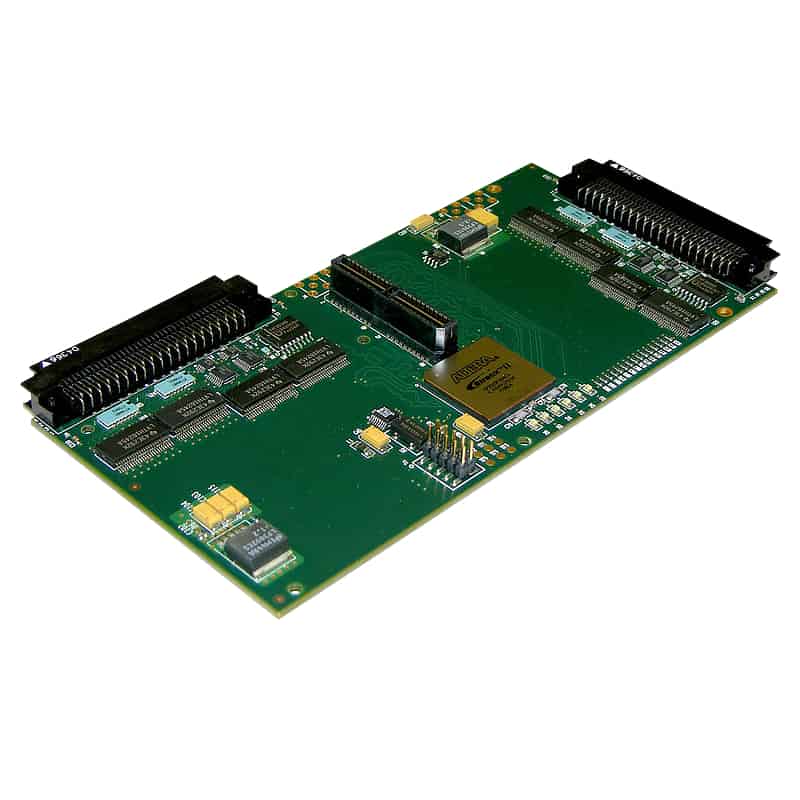
FPDP I & II 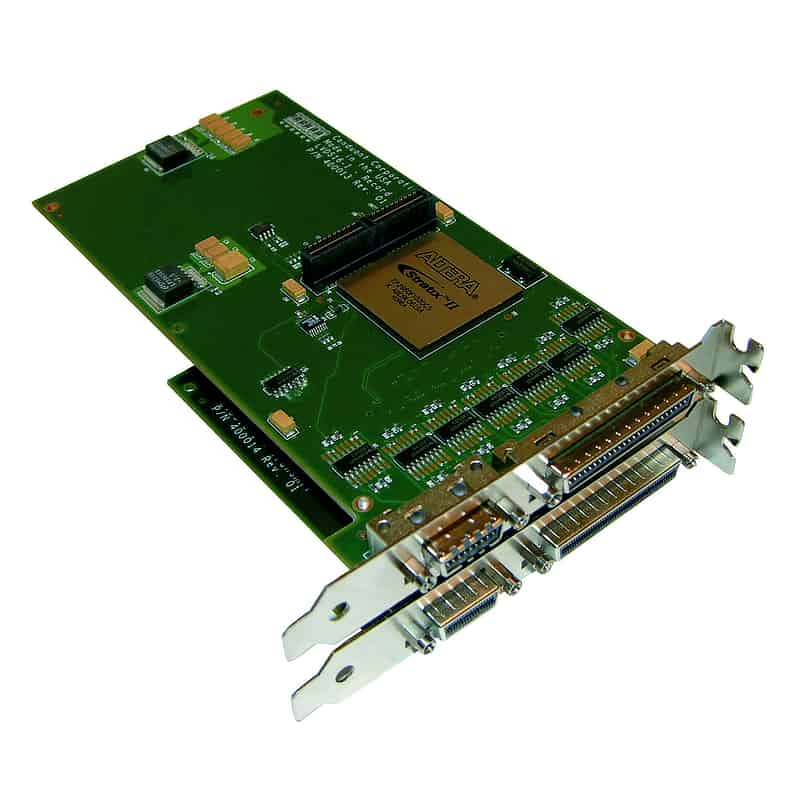
LVDS 16/32 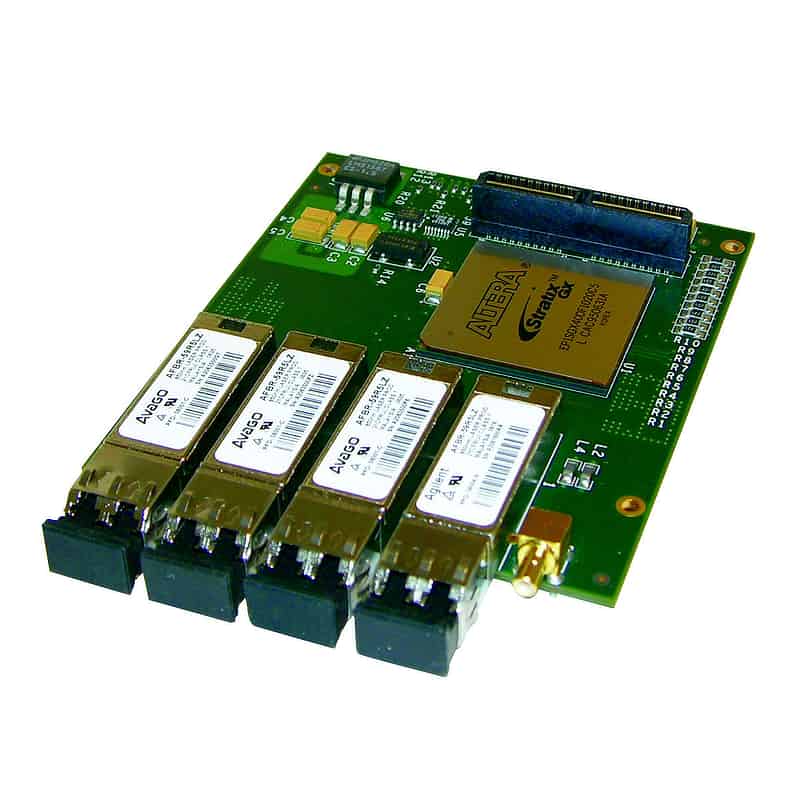
Serial FPDP (optical) 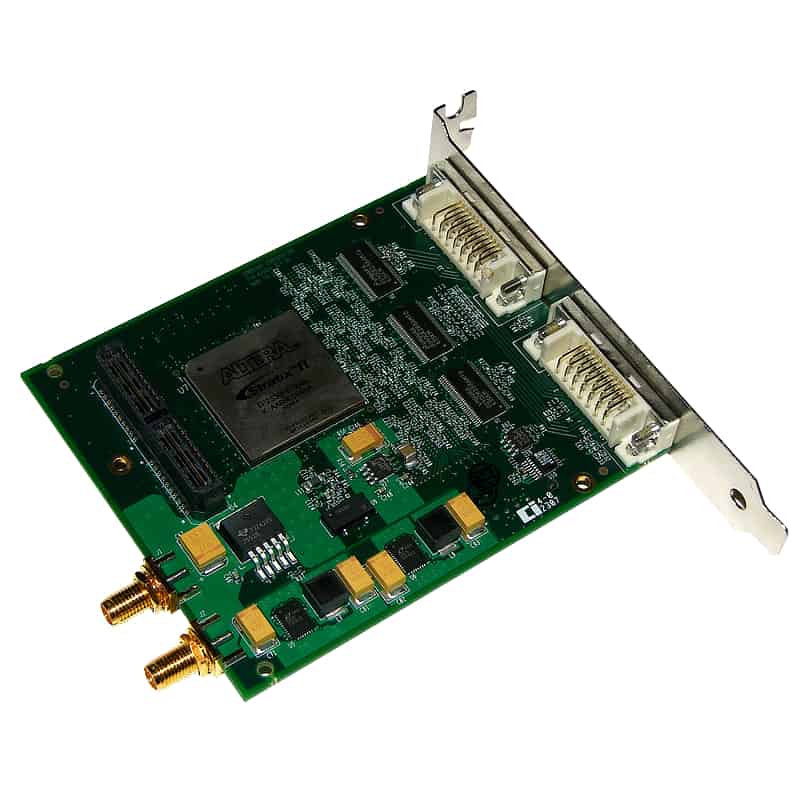
Camera Link Software
The StreamStor® SDK provides drivers and a complete programming library for Windows or Linux operating systems. A recording application and many example programs are included. Advanced features such as circular buffer, partitioning, multi-channel, etc. are available through functions in the StreamStor® software library. Contact your Conduant sales representative for more information on other available features and software.
Storage Media
The Amazon Express supports nearly any SATA disk drive on the market. This includes notebook disk drives (2.5″), desktop disk drives (3.5″), rugged hard drives, and solid-state (flash) drives. Amazon Express is also available in system configurations ranging from portables to large rack-mount systems capable of housing multiple recorders. Contact your sales representative for more information.
-
The StreamStor® SFPDP mezzanine board can be used with compatible StreamStor® controllers to provide direct data input from Serial FPDP (Serial Front Panel Data Port) or other optical data protocols. When combined with a StreamStor® controller such as Amazon, this interface can provide data input performance of up to 500 MB/s.
With its four independent optical ports, the SFPDP mezzanine board can support recording of up to four incoming data streams. The board can be ordered with support for data rates from 1.06 to 2.5 Gbps and wavelengths of 850nm or 1300nm to support cable lengths of up to 25km. The board uses industry standard LC optical connector style for easy connection to compatible data sources.
Standard support is provided for the Serial FPDP protocol (ANSI/VITA 17.1-2003), which is a highly specialized protocol optimized for maximum data rates and minimum overhead. With all packet formation and management performed by the hardware, there is no latency or other delays to affect data transmission performance. Combined with StreamStor® storage controllers, this data interface provides a reliable and sustainable high speed data recording and playback solution. Other protocols can be supported with updates to the on-board Altera Stratix FPGA hardware. The flexibility of programmable logic makes it possible to customize the hardware to each unique application.
Serial FPDP
The serial FPDP protocol is defined by the ANSI / VITA 17.1-2003 standard. The standard is available for a small fee online at www.vita.com. Conduant Corporation also provides hardware source code to customers who wish to implement Serial FPDP on their own FPGA-based circuit boards. Please contact your Conduant sales representative for more details.
Options
SFPDP-4240 (4 port, 850nm, 2.5 Gb) ……………….. PN 400300040
SFPDP-4100 (4 port, 850nm, 1.06 Gb) ………………. PN 400300041
SFPDP-2240 (2 port, 850nm, 2.5 Gb) ……………….. PN 400300035

